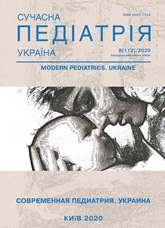Creating an online test to detect the suspicion of congenital immune errors in children
Abstract
As of 2020, more than 400 nosologies of primary immunodeficiencies are known. For most children with this pathology, the key immunological diagnosis remains unclear due to the lack of pathognomonic symptoms, as well as low medical alertness due to the relative rarity of these diseases. Primary immunodeficiencies are not fatal if diagnosed early, moreover, they are treatable with the possibility of a full life or complete recovery. Today, information technology has become an integral part of everyday life. The ability to evaluate a clinical patient record online is a modern important step.
Purpose — to create an online test, available to both physicians and patients, to detect suspicious cases of primary immunodeficiencies in children based on possible clinical manifestations.
Material and methods. Collection and analysis of a child's clinical record on suspicious manifestations of primary immunodeficiency, age and gender comparisons using web technologies. (PHP, MySQL).
Results. International and Ukrainian developments of clinical criteria for suspected primary immunodeficiency in a child have been transformed into an online test containing 35 clinical inquiries to a child's parents or attending physician, followed by analysis of a child's gender and age. As a result, the test user receives the result of the alertness level in terms of urgency to consult a pediatric immunologist.
Conclusions. The immunological online test showed considerable interest, a high detection rate of suspicious cases of primary immunodeficiency. The test can be used with patients who come for an appointment or with hospital patients.
The study was carried out in accordance with the principles of the Helsinki Declaration. The study protocol was approved by the Local Ethics Committee of the institution specified in the work. Informed consent was obtained from the parents of the children for the research.
References
Boostrap CSS. (2020). Build fast, responsive sites with Bootstrap. URL: https://getbootstrap.com.
Bousfiha A, Jeddane L, Picard C et al. (2020). Human Inborn Errors of Immunity: 2019 Update of the IUIS Phenotypical Classification. J Clin Immunol. 40 (1): 66-81. https://doi.org/10.1007/s10875-020-00758-x; PMid:32048120 PMCid:PMC7082388
Chernyshova LI, Bondarenko AV, Kostiuchenko LV, Savvo OM, Volokha AP, Rabosh OV. (2015). Epidemiology of Primary Immunodeficiencies in Ukraine According to Patients' Registry. Za red. Chernyshova LI. Zdorovie Rebionka. 7: 16-23. https://doi.org/10.22141/2224-0551.7.67.2015.75076
Chernyshova LI, Bondarenko AV, Volokha AP. (2015). Criteria for a Suspicious Case of Primary Immunodeficiency in Children (indications for Required Referral to Paediatric Immunologist). Informative letter on healthcare innovations: 226.
Cunningham-Rundles C. (2004). Identifying undiagnosed primary immunodeficiency diseases in minority subjects by using computer sorting of diagnosis codes. Za red. Cunningham-Rundles C, Sidi P, Estrella L, Doucette J. J Allergy Clin Immunol. 113: 747-755. https://doi.org/10.1016/j.jaci.2004.01.761; PMid:15100683
Edgar JD, Buckland M, Guzman D. (2014). The United Kingdom Primary Immune Deficiency (UKPID) Registry: report of the first 4 years' activity 2008-2012. Clin Exp Immunol. 175: 68-78. https://doi.org/10.1111/cei.12172; PMid:23841717 PMCid:PMC3898556
Google. (2020). Google Analytics. URL: https://analytics.google.com.
Modell V. (2011). Global study of primary immunodeficiency diseases (PI) - diagnosis, treatment, and economic impact: an updated report from the Jeffrey Modell Foundation. Modell V, Gee B, Lewis DB et al. Immunol Res. 51: 61-70. https://doi.org/10.1007/s12026-011-8241-y; PMid:21935653
Modell V. (2016). Primary immunodeficiencies worldwide: an updated overview from the Jeffrey Modell Centers Global Network. Za red. Modell V, Quinn J, Orange J, Notarangelo LD, Modell F. Immunol Res. 64: 736-753. https://doi.org/10.1007/s12026-016-8784-z; PMid:26802037
Modell V. (2018). Global report on primary immunodeficiencies: 2018 update from the Jeffrey Modell Centers Network on disease classification, regional trends, treatment modalities, and physician reported outcomes. Za red. Modell V, Orange JS, Quinn J, Modell F. Immunol Res. 66: 367. https://doi.org/10.1007/s12026-018-8996-5; PMid:29744770
Picard C. (2018). International Union of Immunological Societies: 2017 Primary Immunodeficiency Diseases Committee Report on Inborn Errors of Immunity. Za red. Picard C, Bobby Gaspar H, Al-Herz W. Journal of Clinical Immunology. 38: 96-128. https://doi.org/10.1007/s10875-017-0464-9; PMid:29226302 PMCid:PMC5742601
Project RAPID. (2017). NGO «Ukrainian Association of Pediatric Immunology». URL: https://www.vadi.org.ua/rapid.
Rosen F, Eibl M, Roifman C. (1999). Primary Immunodeficiency Diseases Report of an IUIS Scientific Committee. Clinical and Experimental Immunology. Clin Exp Immunol. 118: 1-28. https://doi.org/10.1046/j.1365-2249.1999.00109.x; PMid:10540200 PMCid:PMC1905383
Downloads
Published
Issue
Section
License
The policy of the Journal “MODERN PEDIATRICS. UKRAINE” is compatible with the vast majority of funders' of open access and self-archiving policies. The journal provides immediate open access route being convinced that everyone – not only scientists - can benefit from research results, and publishes articles exclusively under open access distribution, with a Creative Commons Attribution-Noncommercial 4.0 international license (СС BY-NC).
Authors transfer the copyright to the Journal “MODERN PEDIATRICS. UKRAINE” when the manuscript is accepted for publication. Authors declare that this manuscript has not been published nor is under simultaneous consideration for publication elsewhere. After publication, the articles become freely available on-line to the public.
Readers have the right to use, distribute, and reproduce articles in any medium, provided the articles and the journal are properly cited.
The use of published materials for commercial purposes is strongly prohibited.

